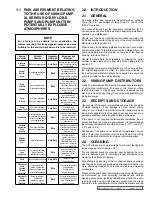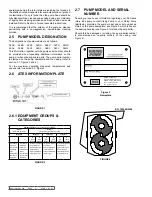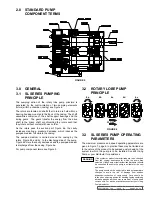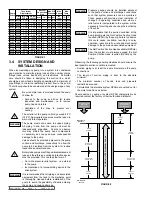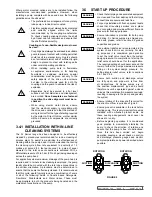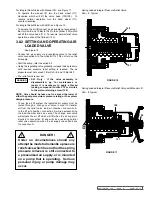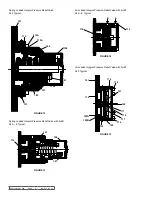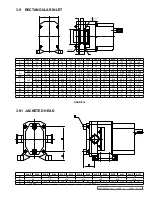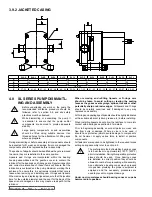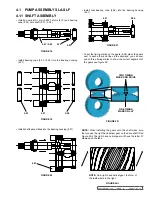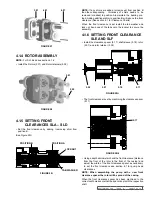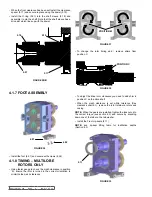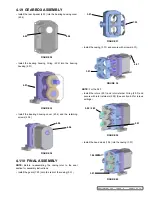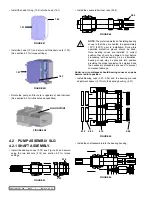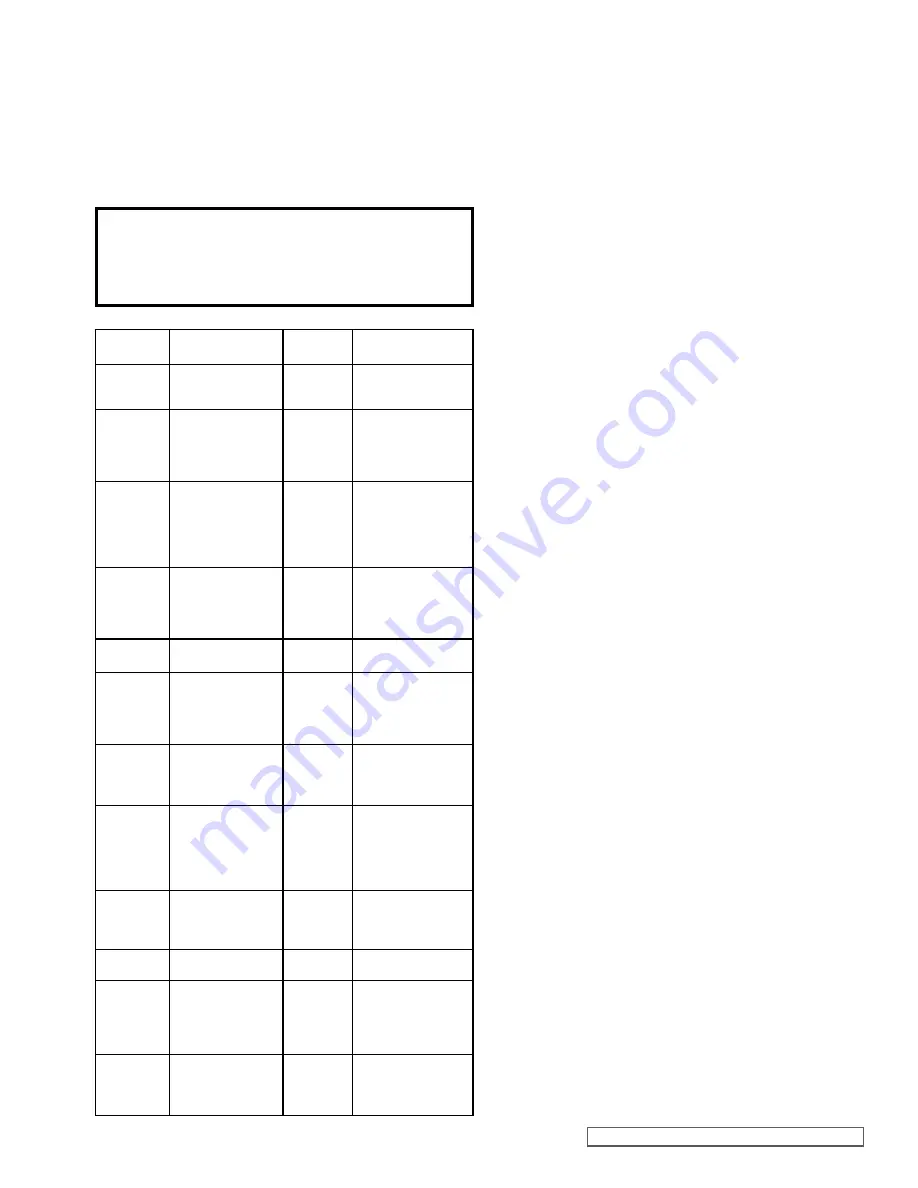
SECTION TSM 288
ISSUE
A
PAGE 3 OF 36
Source
of Hazards
Potential
Hazards
Frequency
of Hazards
Recommended
Measures
Unvented
Cavities
Build up of explosive gas
Very Rare
Ensure that pump is totally
filled. Consider mounting
ports vertically.
Casing /
Rotors /
Head
Unintended mechanical
contact
Rare
Ensure that operating
pressures are not
exceeded. Ensure that
sufficient NPSH to prevent
cavitation. Service Plan.
Pump
External
Surfaces
Excess temperature.
Electrostatic charging
Rare
User must ensure
temperature limits. Do not
overfill gearboxes with
lubricant. Provide a ground
contact for pump.
Service plan.
Cover
O-Ring
Pump liquid leakage.
Build up of explosive gas
Very Rare
Check selection of
elastomers are suitable for
application. Ensure cover
retaining nuts are tight.
Service plan.
Pump
Casing / Cover
Pump liquid leakage.
Build up of explosive gas
Very Rare
Stainless Steel.
Corrosion Resistant.
Shaft Seals
Excessive temperature.
Unintended mechanical
contact. Leakage.
Build
up of explosive gas
Rare
Selection of seal system
must be suitable for
application. Manual.
Service plan. Seals must
never run dry.
Auxiliary
System for
Shaft
Sealing
Pump liquid leakage.
Build up of explosive gas
Rare
Selection of auxiliary seal
system must be suitable
for application. Seals must
never run dry.
Rotation
Direction
Test
Excess Temperature
Very Rare
If flushed seals are
installed, ensure that
flush is applied to seal
assemblies. Only allow
pump to run for minimum
period - just a few seconds.
Closed
Valve
Condition
Excess Temperature.
Excess Pressure.
Mechanical Contact
Rare
Can cause excessive
pressure, heat and
mechanical contact.
Manual.
Shaft
Random induced current
Very Rare
Provide a ground
contact for pump.
Mechanical
Shaft
Coupling
(Torque
Protection)
Temperature from
friction. Sparks from
break up of shear pins.
Electrostatic charging
Rare
Coupling selection must
suit application.
Provide ground
contact for pump.
Mechanical
Shaft
Coupling
(Standard)
Break up of spider.
Unintended
mechanical contact.
Electrostatic charging
Rare
Coupling selection must
suit application. Service
plan. Provide ground
contact for pump.
NOTE
for a feature to be suitable for an application, the
feature must be fit for its designated purpose and also
suitable for the environment where it is to be installed.
1.1 RIsK assEssMENT RElaTING
TO THE UsE Of VIKING PUMP
sl sERIEs ROTaRY lObE
PUMPs aNd PUMP UNITs IN
POTENTIallY EXPlOsIVE
aTMOsPHEREs
2.0 INTROdUCTION
2.1 GENERal
SL Series rotary lobe pumps are manufactured by Johnson
Pump (UK) Ltd. , a subsidiary of Viking Pump Co., (a unit of the
IDEX Corporation).
This manual includes all the necessary information for SL
Series pumps and should be read prior to beginning installation,
operation, or maintenance.
Should you require any additional information regarding the
SL Series pumps contact Viking Pump or their local authorized
distributor, refer to section 2.2.
When asking for assistance please provide the pump model
and serial number. This information can be obtained from the
pump nameplate which is located on the side of the bearing
housing, refer to section 2.7.
Should the nameplate be unreadable or missing the serial
number is also stamped on either side of the casing refer to
section 2.7.
If the system or product characteristics are to be changed from
the original application for which the pump was selected, or
their authorized distributor should be consulted to ensure the
pump is suitable for the new application.
2.2 VIKING PUMP dIsTRIbUTORs
Viking Pump distributes its products internationally via a network
of authorized distributors. Throughout this manual where
reference is made to Viking Pump, service and assistance will
also be provided by any Viking Pump authorized distributor for
SL Series pumps.
2.3 RECEIPTs aNd sTORaGE
Upon receipt of the pump, immediately examine it for any signs
of visible damage. If any damage is noted, contact Viking
Pump or your Viking Pump distributor and clearly mark upon
the carriers’ paperwork that the goods have been received in a
damaged condition, with a brief description of damage.
If the pump is not required for immediate installation then it
should be stored in a clean, dry environment. It is recommended
that storage temperature should be between –10°C and 40°C
(14°F and 105°F).
Additionally, if the pump is not intended for installation or use
within 18 months or more then refer to Viking Pump or the Viking
Pump authorized distributor for storage recommendations.
2.4 ClEaNING
The SL Series pump range is suitable for manual cleaning and
in-line cleaning refer to section 3.4.1.
The mechanical seals are mounted directly behind the rotor
and are designed and to minimize product entrapment and
maximize the effects of cleaning.
This strategic positioning of the mechanical seals, combined
with their ease of access provides an arrangement that can be
more effectively cleaned by both manual and in-line cleaning
procedures.
Whenever the pump head is dismantled, and at regular intervals
as determined by local operating conditions and verified
cleaning procedures, including installations where the pump
is only operated using n-line cleaning procedures, the areas
behind the rotor case adjacent to the mechanical seals and the



